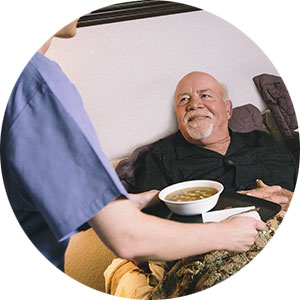Alzheimer’s Care at Home
 Caring for a person with Alzheimer’s disease at home is a challenging task that can become overwhelming at times. Each day brings new demands and challenges as the caregiver copes with changing levels of ability and new patterns of behavior. In any demanding situation, the better you care for yourself, the better you will be able to care for your loved one.
Caring for a person with Alzheimer’s disease at home is a challenging task that can become overwhelming at times. Each day brings new demands and challenges as the caregiver copes with changing levels of ability and new patterns of behavior. In any demanding situation, the better you care for yourself, the better you will be able to care for your loved one.
Setting up home care
Soon after a diagnosis of Alzheimer’s, it will be necessary to get started on making changes that help provide a sense of well being and physical safety for the affected person. Things that were taken for granted before, such as home safety and socializing, will now require some planning. There will be a need to communicate in new ways and make changes to the home environment. These changes include:
-
Adjusting your communication style to your loved one’s changing needs as the disease progresses.
-
Scheduling visitors to avoid surprises and have something to look forward to. Even if the elder with dementia does not recognize those who visit, the contact is nonetheless valuable for them.
-
Establishing routines in activities of daily living.
-
Maintaining social contacts and fun.
-
Setting up a safe home environment.
-
Considering placement in a facility or hiring a private in-home care agency if caregiving becomes unmanageable for you or your loved one.
Whether it’s assisted living placement or in-home support services, Always Best Care’s trained staff can help!
Promoting comfort and safety
As the symptoms of Alzheimer’s progress, the person becomes more emotionally fragile. At first, there may be the sense of grief and dread that accompanies the awareness of having a progressive, terminal illness. During this early stage of the disease, caregivers can promote the patient’s sense of well being by providing emotional support and by helping to maintain familiar activities and social contacts. Eventually though, the diagnosis of Alzheimer’s is forgotten and the ability to be rational fades. Logical thinking can no longer be used to help alleviate fear and confusion. As problems with memory and judgment increase, the patient becomes more vulnerable to accidents and injuries. Problem behaviors develop that place the person at increased risk of getting lost or getting hurt. Caregivers must hone communication skills and make changes to the home environment in anticipation of the problems of mid-stage Alzheimer’s disease.










